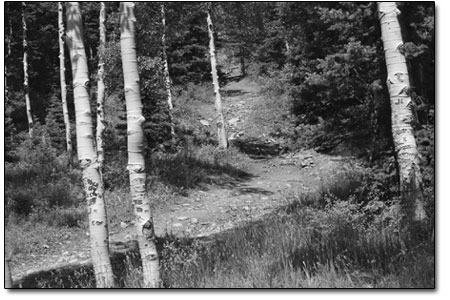| ||
An alpine makeover
by Shawna Bethell If you’ve spent much time in the Alpine Triangle between Silverton, Ouray and Lake City recently, you are aware of the mass of metal, exhaust and wandering humanity the area has become. Throw in a holiday like Fourth of July or Memorial Day, and you find yourself celebrating with literally thousands of your closest friends compacted onto the backcountry trail systems. The Alpine Triangle last got guidance way back in 1986 with when the Bureau of Land Management handed down a Recreation Area Management Plan (RAMP). With a dramatic increase in numbers of recreational users and a shift in the type of recreation, the BLM decided it was time to reconsider land management in the area. The agency issued a new RAMP for the Alpine Triangle in October. “There were no specific incidents that caused us to reevaluate what’s going on up there,” said Jed Botsford, Outdoor Recreation Planner for the BLM. “But a plan only has a life of about 10 to 20 years, so it was time to revisit and update it.” There are no sweeping changes in the new RAMP, which attempts to manage the increase in use and keep damage to fragile alpine ecosystem and historic landmarks as minimal as possible. Off-highway vehicles are the most obvious users of the Alpine Triangle. On narrow high country roads, the right of way goes to the downhill traveler, and motorists traveling uphill typically pull to the side. But during events such as the Jeep Jamboree, where multiple drivers are traveling together, the wait for the right of way can get irritatingly long. The new plan restricts group rides to 10 vehicles, and groups need to be spaced an hour apart allowing other users more courtesy. And where the previous plan already restricted motorized vehicles to designated trails, the new plan now adds mountain bikes to the list, restricting them to trails as well. “It’s not that bikes are motorized vehicles,” said Botsford. “But there really shouldn’t be any cross country travel for anyone. People don’t realize that once a track is made, others follow and more damage is done.” Other non-motorized users will need to familiarize themselves with the new restrictions as well. A relatively new use of outdoor areas is geocaching, which is basically treasure hunting via GPS. Plastic containers filled with “goods” are hidden, and then the coordinates are listed via www.geocaching.com. Other players log in, get the coordinates, head into the great outdoors to find the treasure, then go back to post their story on the website. According to geocaching.com, there are 1.2 million “caches” hidden worldwide, and some of them have found their way to the Alpine Triangle. “We’ve seen a higher concentration of use in these areas,” said Botsford. “And it’s not a problem while people are on the designated trails, but when they get closer to the treasure, we find a larger number of meandering trails caused by people looking for the cache site.” The new RAMP attempts to reduce geocaching’s potential to degrade natural or cultural resources and bans artificial geocaches in wilderness and wilderness study areas. One of the changes to the RAMP that brought the most concern during the public comment period was the BLM’s attempt to spread events evenly throughout the season. This was an effort to allow the wilderness areas to recuperate between onslaughts of people and allow the local tourist economies a more steady income. “We’re trying to encourage future permitees not to plan their events at high season but consider planning for shoulder seasons,” said Botsford. “There was a misconception during the comment period, but events that are already in place will not be changed. For those applying for new events, alternatives to high-activity weekends will be suggested.” For those planning to “stay over” in the 186,252 acres of the triangle, the new RAMP bans camping and campfires within 150 feet of historic structures. Furthermore, permanent climbing anchors in Wilderness and Wilderness Study Areas are also banned. “Many visitors see the things they can’t do, and they don’t understand why,” said Botsford. “They see ATV commercials on television romanticizing mud bogging and think it looks fun. So when they get here, they take off bogging through a mud puddle, and maybe that’s fine on private land, but not public lands. It takes years for a meadow to heal after something like that happens,” he said. “Educating our visitors about these issues is number one.” • To see the entire RAMP, visit http://www.blm.gov/co/st/en/fo/gfo/loop_plan.html.
|
In this week's issue...
- May 15, 2025
- End of the trail
Despite tariff pause, Colorado bike company can’t hang on through supply chain chaos
- May 8, 2025
- Shared pain
Dismal trend highlights need to cut usage in Upper Basin, too
- April 24, 2025
- A tale of two bills
Nuclear gets all the hype, but optimizing infrastructure will have bigger impact


